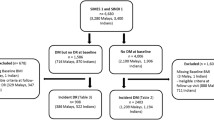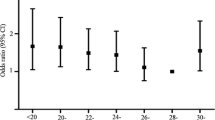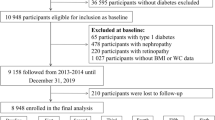Abstract
Aims
Obesity has been proposed to promote the progression of diabetic retinopathy (DR), but previous studies have not shown consistent results. We aimed to explore the association between generalized and abdominal obesity and DR risk, and to assess the joint effect of these two different types of obesity on DR development.
Methods
A nested case–control study within a large prospective study on type 2 diabetes was conducted in communities in Huai’an City, Jiangsu Province, China. Cases were individuals who had diagnoses of DR during the 6-year follow-up. A total number of 1544 DR cases and 1:1 matched controls were included. Binomial and multinomial logistic regression models were used to investigate the effects of obesity on DR occurrence and DR severity.
Results
Compared with individuals in the first tertile of the baseline waist-to-hip ratio (WHR), subjects in the third tertile at baseline had significantly higher risk of DR (OR 1.44, 95% CI 1.17–1.78) during the follow-up period. Conversely, body mass index (BMI) (continuous) had an adjusted OR of 0.97 (95% CI 0.95–0.99) of developing DR. Individuals with low BMI and high WHR levels were identified as a high-risk population with a higher likelihood of developing DR (OR 1.65, 95% CI 1.17–2.33) than those in the lowest BMI category and simultaneously in the first WHR tertile.
Conclusions
Type 2 diabetic individuals with low BMI levels and high WHR levels had a significantly increased risk of developing DR which indicated that isolated abdominal obesity might be involved in the pathogenesis of DR.



Similar content being viewed by others
References
Saaddine JB, Honeycutt AA, Narayan KM, Zhang X, Klein R, Boyle JP (2008) Projection of diabetic retinopathy and other major eye diseases among people with diabetes mellitus: United States, 2005–2050. Arch Ophthalmol 126(12):1740–1747. https://doi.org/10.1001/archopht.126.12.1740
Bandello F, Lattanzio R, Zucchiatti I, Del Turco C (2013) Pathophysiology and treatment of diabetic retinopathy. Acta Diabetol 50(1):1–20. https://doi.org/10.1007/s00592-012-0449-3
Madonna R, Giovannelli G, Confalone P, Renna FV, Geng YJ, De Caterina R (2016) High glucose-induced hyperosmolarity contributes to COX-2 expression and angiogenesis: implications for diabetic retinopathy. Cardiovasc Diabetol 15:18. https://doi.org/10.1186/s12933-016-0342-4
Iglicki M, Zur D, Fung A et al (2019) TRActional DIabetic reTInal detachment surgery with co-adjuvant intravitreal dexamethasONe implant: the TRADITION STUDY. Acta Diabetol 56(10):1141–1147. https://doi.org/10.1007/s00592-019-01357-y
Iglicki M, Zur D, Busch C, Okada M, Loewenstein A (2018) Progression of diabetic retinopathy severity after treatment with dexamethasone implant: a 24-month cohort study the “DR-Pro-DEX Study.” Acta Diabetol 55(6):541–547. https://doi.org/10.1007/s00592-018-1117-z
Yau JW, Rogers SL, KawasakiBek R et al (2012) Global prevalence and major risk factors of diabetic retinopathy. Diabetes Care 35(3):556–564. https://doi.org/10.2337/dc11-1909
Younis N, Broadbent DM, Vora JP, Harding SP (2003) Incidence of sight-threatening retinopathy in patients with type 2 diabetes in the Liverpool Diabetic Eye Study: a cohort study. Lancet 361(9353):195–200. https://doi.org/10.1016/s0140-6736(03)12267-2
Cheung N, Mitchell P, Wong TY (2010) Diabetic retinopathy. Lancet 376(9735):124–136. https://doi.org/10.1016/s0140-6736(09)62124-3
Ding J, Wong TY (2012) Current epidemiology of diabetic retinopathy and diabetic macular edema. Curr Diab Rep 12(4):346–354. https://doi.org/10.1007/s11892-012-0283-6
Nguyen NT, Nguyen XM, Lane J, Wang P (2011) Relationship between obesity and diabetes in a US adult population: findings from the National Health and Nutrition Examination Survey, 1999–2006. Obes Surg 21(3):351–355. https://doi.org/10.1007/s11695-010-0335-4
Dirani M, Xie J, Fenwick E et al (2011) Are obesity and anthropometry risk factors for diabetic retinopathy? The diabetes management project. Invest Ophthalmol Vis Sci 52(7):4416–4421. https://doi.org/10.1167/iovs.11-7208
World Health Organization (2021) Obesity and overweight. https://www.who.int/en/news-room/fact-sheets/detail/obesity-and-overweight. Accessed 9 June 2021
van Leiden HA, Dekker JM, Moll AC et al (2002) Blood pressure, lipids, and obesity are associated with retinopathy: the hoorn study. Diabetes Care 25(8):1320–1325. https://doi.org/10.2337/diacare.25.8.1320
Keen H, Lee ET, Russell D, Miki E, Bennett PH, Lu M (2001) The appearance of retinopathy and progression to proliferative retinopathy: the WHO Multinational Study of Vascular Disease in Diabetes. Diabetologia 44(Suppl 2):S22-30. https://doi.org/10.1007/pl00002935
Group DPPR (2007) The prevalence of retinopathy in impaired glucose tolerance and recent-onset diabetes in the Diabetes Prevention Program. Diabet Med 24(2):137–144. https://doi.org/10.1111/j.1464-5491.2007.02043.x
Zhu W, Wu Y, Meng YF, Xing Q, Tao JJ, Lu J (2018) Association of obesity and risk of diabetic retinopathy in diabetes patients: a meta-analysis of prospective cohort studies. Medicine (Baltimore) 97(32):e11807. https://doi.org/10.1097/md.0000000000011807
Looker HC, Nyangoma SO, Cromie D et al (2012) Diabetic retinopathy at diagnosis of type 2 diabetes in Scotland. Diabetologia 55(9):2335–2342. https://doi.org/10.1007/s00125-012-2596-z
Wong TY, Klein R, Islam FM et al (2006) Diabetic retinopathy in a multi-ethnic cohort in the United States. Am J Ophthalmol 141(3):446–455. https://doi.org/10.1016/j.ajo.2005.08.063
Dowse GK, Humphrey AR, Collins VR et al (1998) Prevalence and risk factors for diabetic retinopathy in the multiethnic population of Mauritius. Am J Epidemiol 147(5):448–457. https://doi.org/10.1093/oxfordjournals.aje.a009470
Zhou JB, Yuan J, Tang XY et al (2019) Is central obesity associated with diabetic retinopathy in Chinese individuals? An exploratory study. J Int Med Res 47(11):5601–5612. https://doi.org/10.1177/0300060519874909
Man RE, Sabanayagam C, Chiang PP et al (2016) Differential Association of generalized and abdominal obesity with diabetic retinopathy in Asian patients with type 2 diabetes. JAMA Ophthalmol 134(3):251–257. https://doi.org/10.1001/jamaophthalmol.2015.5103
Deurenberg-Yap M, Chew SK, Deurenberg P (2002) Elevated body fat percentage and cardiovascular risks at low body mass index levels among Singaporean Chinese. Malays Indians Obes Rev 3(3):209–215. https://doi.org/10.1046/j.1467-789x.2002.00069.x
Rush EC, Freitas I, Plank LD (2009) Body size, body composition and fat distribution: comparative analysis of European, Maori, Pacific Island and Asian Indian adults. Br J Nutr 102(4):632–641. https://doi.org/10.1017/s0007114508207221
Miao DD, Pan EC, Zhang Q, Sun ZM, Qin Y, Wu M (2017) Development and validation of a model for predicting diabetic nephropathy in Chinese people. Biomed Environ Sci 30(2):106–112. https://doi.org/10.3967/bes2017.014
Li M, Wu M, Qin Y et al (2019) ACTB variants confer the genetic susceptibility to diabetic kidney disease in a Han Chinese population. Front Genet 10:663. https://doi.org/10.3389/fgene.2019.00663
Shen C, Wen J, Pan X et al (2018) Age at menarche and age at natural menopause as predictors of glycemic control in type 2 diabetic patients. J Diabetes Complications 32(7):623–629. https://doi.org/10.1016/j.jdiacomp.2018.04.012
Millán J, Pintó X, Muñoz A et al (2009) Lipoprotein ratios: physiological significance and clinical usefulness in cardiovascular prevention. Vasc Health Risk Manag 5:757–765
International Council of Ophthalmology (2017) ICO guidelines for diabetic eye care. http://www.icoph.org/enhancing_eyecare/diabetic_eyecare.html. Accessed January 2017
Consultation WE (2004) Appropriate body-mass index for Asian populations and its implications for policy and intervention strategies. Lancet 363(9403):157–163. https://doi.org/10.1016/s0140-6736(03)15268-3
(2000) WHO. The Asia Pacific perspective, redefining obesity and its treatment: International Association for the Study of Obesity and International Obesity Task Force. In: International Diabetes Institute M, editor
Kumari N, Bhargava M, Nguyen DQ et al (2019) Six-year incidence and progression of diabetic retinopathy in Indian adults: the Singapore Indian Eye study. Br J Ophthalmol 103(12):1732–1739. https://doi.org/10.1136/bjophthalmol-2018-313282
Raman R, Rani PK, Gnanamoorthy P, Sudhir RR, Kumaramanikavel G, Sharma T (2010) Association of obesity with diabetic retinopathy: Sankara Nethralaya Diabetic Retinopathy Epidemiology and Molecular Genetics Study (SN-DREAMS Report no. 8). Acta Diabetol 47(3):209–215. https://doi.org/10.1007/s00592-009-0113-8
Pang C, Jia L, Jiang S et al (2012) Determination of diabetic retinopathy prevalence and associated risk factors in Chinese diabetic and pre-diabetic subjects: Shanghai diabetic complications study. Diabetes Metab Res Rev 28(3):276–283. https://doi.org/10.1002/dmrr.1307
Horwich TB, Fonarow GC, Clark AL (2018) Obesity and the obesity paradox in heart failure. Prog Cardiovasc Dis 61(2):151–156. https://doi.org/10.1016/j.pcad.2018.05.005
George AM, Jacob AG, Fogelfeld L (2015) Lean diabetes mellitus: an emerging entity in the era of obesity. World J Diabetes 6(4):613–620. https://doi.org/10.4239/wjd.v6.i4.613
Romero-Corral A, Somers VK, Sierra-Johnson J et al (2010) Normal weight obesity: a risk factor for cardiometabolic dysregulation and cardiovascular mortality. Eur Heart J 31(6):737–746. https://doi.org/10.1093/eurheartj/ehp487
Wan H, Wang Y, Xiang Q et al (2020) Associations between abdominal obesity indices and diabetic complications: Chinese visceral adiposity index and neck circumference. Cardiovasc Diabetol 19(1):118. https://doi.org/10.1186/s12933-020-01095-4
Fujimoto WY, Abbate SL, Kahn SE, Hokanson JE, Brunzell JD (1994) The visceral adiposity syndrome in Japanese-American men. Obes Res 2(4):364–371. https://doi.org/10.1002/j.1550-8528.1994.tb00076.x
Panagiotakos DB, Pitsavos C, Yannakoulia M, Chrysohoou C, Stefanadis C (2005) The implication of obesity and central fat on markers of chronic inflammation: the ATTICA study. Atherosclerosis 183(2):308–315. https://doi.org/10.1016/j.atherosclerosis.2005.03.010
Anan F, Takayuki M, Takahashi N et al (2009) Diabetic retinopathy is associated with insulin resistance and cardiovascular autonomic dysfunction in type 2 diabetic patients. Hypertens Res 32(4):299–305. https://doi.org/10.1038/hr.2009.8
Joussen AM, Poulaki V, Le ML et al (2004) A central role for inflammation in the pathogenesis of diabetic retinopathy. Faseb J 18(12):1450–1452. https://doi.org/10.1096/fj.03-1476fje
Maneschi F, Mashiter K, Kohner EM (1983) Insulin resistance and insulin deficiency in diabetic retinopathy of non-insulin-dependent diabetes. Diabetes 32(1):82–87. https://doi.org/10.2337/diab.32.1.82
Fenner BJ, Wong RLM, Lam WC, Tan GSW, Cheung GCM (2018) Advances in retinal imaging and applications in diabetic retinopathy screening: a review. Ophthalmol Ther 7(2):333–346. https://doi.org/10.1007/s40123-018-0153-7
Bernardes R, Serranho P, Lobo C (2011) Digital ocular fundus imaging: a review. Ophthalmologica 226(4):161–181. https://doi.org/10.1159/000329597
Li HK, Hubbard LD, Danis RP et al (2010) Digital versus film Fundus photography for research grading of diabetic retinopathy severity. Invest Ophthalmol Vis Sci 51(11):5846–5852. https://doi.org/10.1167/iovs.09-4803
Acknowledgements
We would like to thank the patients and staff for their important contributions. This study was funded by Jiangsu Provincial Leading Talents and Innovation Team Program (K201105), Jiangsu Provincial Fifth “333 Project” (BRA2020090) and Jiangsu Provincial Health Commission 2020 Medical Research Project (M2020085).
Author information
Authors and Affiliations
Contributions
MW, JyZ, CS, YQ, ZZ, JS and YnW performed literature search, study design, data collection and data interpretation; JxC was involved in data collection, data interpretation, data analysis and writing; EcP, JbW, KW and HY carried out literature search and data collection; LC contributed to literature search, study design and data interpretation and MW, JyZ, JS, YnW and JxC had access to the raw data. MW had full access to all the data in the study and the final responsibility for the decision to submit for publication.
Corresponding author
Ethics declarations
Conflict of interest
The authors declare that they have no conflict of interest.
Ethical Standard Statement
Ethics approval for this study was granted by the Ethics Board of Jiangsu Provincial Center for Disease Control and Prevention.
Informed consent
Informed consent was obtained from all patients included in the study. All participants signed an informed consent document before participation.
Additional information
Publisher's Note
Springer Nature remains neutral with regard to jurisdictional claims in published maps and institutional affiliations.
This article belongs to the topical collection Eye Complications of Diabetes, managed by Giuseppe Querques.
Supplementary Information
Below is the link to the electronic supplementary material.
Rights and permissions
About this article
Cite this article
Chen, J., Wan, Y., Su, J. et al. Association of Generalized and Abdominal Obesity with Diabetic Retinopathy in Chinese Type 2 Diabetic Patients. Acta Diabetol 59, 359–367 (2022). https://doi.org/10.1007/s00592-021-01806-7
Received:
Accepted:
Published:
Issue Date:
DOI: https://doi.org/10.1007/s00592-021-01806-7




